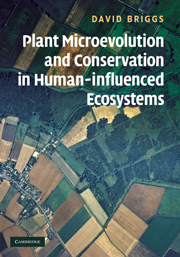Book contents
- Frontmatter
- Contents
- Preface
- Acknowledgements
- List of abbreviations
- 1 Introduction
- 2 Studying change
- 3 Key concepts in plant evolution
- 4 The origin and extent of human-influenced ecosystems
- 5 Consequences of human influences on the biosphere
- 6 Categories
- 7 Investigating microevolution in plants in anthropogenic ecosystems
- 8 Plant microevolution in managed grassland ecosystems
- 9 Harvesting crops: arable and forestry
- 10 Pollution and microevolutionary change
- 11 Introduced plants
- 12 Endangered species: investigating the extinction process at the population level
- 13 Hybridisation and speciation in anthropogenically influenced ecosystems
- 14 Ex situ conservation
- 15 In situ conservation: within and outside reserves
- 16 Creative conservation through restoration and reintroduction
- 17 Reserves in the landscape
- 18 Climate change
- 19 Microevolution and climate change
- 20 The implications of climate change for the theory and practice of conservation
- 21 Overview
- References
- Index
13 - Hybridisation and speciation in anthropogenically influenced ecosystems
Published online by Cambridge University Press: 05 June 2012
- Frontmatter
- Contents
- Preface
- Acknowledgements
- List of abbreviations
- 1 Introduction
- 2 Studying change
- 3 Key concepts in plant evolution
- 4 The origin and extent of human-influenced ecosystems
- 5 Consequences of human influences on the biosphere
- 6 Categories
- 7 Investigating microevolution in plants in anthropogenic ecosystems
- 8 Plant microevolution in managed grassland ecosystems
- 9 Harvesting crops: arable and forestry
- 10 Pollution and microevolutionary change
- 11 Introduced plants
- 12 Endangered species: investigating the extinction process at the population level
- 13 Hybridisation and speciation in anthropogenically influenced ecosystems
- 14 Ex situ conservation
- 15 In situ conservation: within and outside reserves
- 16 Creative conservation through restoration and reintroduction
- 17 Reserves in the landscape
- 18 Climate change
- 19 Microevolution and climate change
- 20 The implications of climate change for the theory and practice of conservation
- 21 Overview
- References
- Index
Summary
This chapter considers a number of questions relating to hybridisation and speciation in ecosystems disturbed by human activities. Many species of plants are currently endangered. If there are many extinctions in the near future, will new species quickly evolve to take their place? As a consequence of human activities, a large number of species of plants have been introduced accidentally or deliberately across the world. What are the consequences of such human-induced breakdown of geographical isolation between species? Agricultural landscapes cover a large area of the globe. What have been the microevolutionary effects of the interaction of crop, wild, garden and weedy plants? Finally, what are the implications for conservation of species hybridisation in anthropogenic ecosystems?
Will new species quickly evolve to take the place of those that become extinct?
Human activities produce many patchy and mosaic habitats. In situations where a genetically polymorphic species occurs in two or more adjacent habitats, disruptive selection is likely to take place and this could provide the setting for the early stages of speciation. An example shows the possibilities. In many parts of Britain, within the extensive pasture lands there exist islands of heavy-metal contaminated debris and spoil left by the mining industry. As we saw in Chapter 10, where a species occurs both on the mine debris and in the pasture, there is evidence of gene flow and disruptive selection. Pasture plants are heavy-metal sensitive and cannot grow on the mine: mine plants perform less successfully in the pasture.
- Type
- Chapter
- Information
- Publisher: Cambridge University PressPrint publication year: 2009

